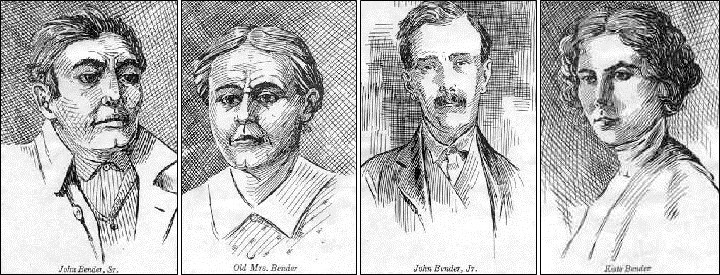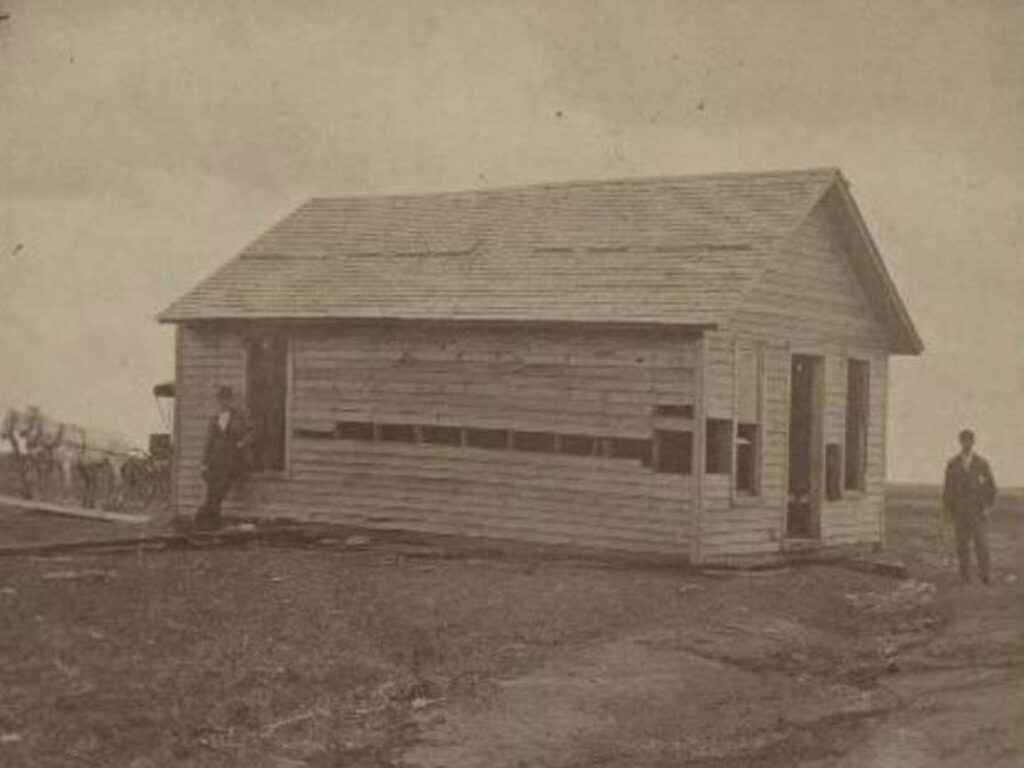Last updated on October 30th, 2023 at 06:35 pm
When travelers started disappearing near Osage Township, close to the southeastern corner of Kansas, no one took much notice at first.
It was the 1870s, and the frontier could still be a wild, hostile place. Near the border with the Indian Territory (which became the state of Oklahoma in 1907), criminals roamed beyond the reach of law enforcement. Even the land itself could be deadly. So a few missing people didn’t raise eyebrows.
It wasn’t until 1873, when a doctor named William York disappeared while traveling home through that part of Kansas, that an investigation was launched.
The doctor’s brother, Alexander York, was a local politician determined to discover what had happened. He eventually tracked William’s trail through Kansas until it led him to a one-room cabin the Benders, a family of German immigrants owned.
With a search party in tow, Alexander visited the Bender family at their property and peppered them with questions about his brother. Ma and Pa Bender and their adult children, John and Kate, seemed oddly quiet and reluctant to provide answers, but they did divulge that William had eaten with them as he passed through.
Alexander left feeling uneasy, and that night he decided he would return the next day to search the property.
But even as he decided to return, the Benders were frantically packing their belongings and preparing to leave.
The family was gone when Alexander showed up with a group of men at their cabin the next day. He found clothing strewn about on the floor, damaged furniture, and other items thrown about in disarray.
A curtain separated the general store from the kitchen and dining area.
He pulled back the curtain and noticed a trap door concealed in the floor. When he opened it, he was horrified by the stench rushing out to meet him.
The smell of death came from a mass of rotting corpses, some of which had been there so long that they were no longer recognizable.
By the end of the investigation, Alexander and his men found a total of 11 bodies hidden on the property, one of which was his own brother, William York. Alexander uncovered the gruesome work of America’s first serial killer family.
And they had just gotten away.

Who Were the Bloody Benders?
The Bender family consisted of four members – John and Ma Bender, an older German couple, a son who went by John, and a daughter named Kate.
When they first arrived in the area in October 1870, they were just one of hundreds of families who moved in after the army had rounded up the last Osage Indians.
They were there to take advantage of the government’s land grant policy, which offered 160-acre plots to anyone willing to settle for five or more years.
Although people started disappearing soon after their arrival, no one connected the disappearances to this somewhat reclusive yet otherwise typical immigrant family.
The Benders turned their home into an inn, taking in all kinds of travelers. They also operated a general store, selling supplies like candles and dried food.
With so many people headed west in the years following the Civil War, the Bender family home became a popular stopping point for anyone crossing through southeastern Kansas.
After discovering the 11 bodies on the Bender property, townspeople came forward to offer their descriptions of the family.
They remembered that the older couple mainly spoke German and always had a thick accent. The younger John was slender with blue eyes and brown hair. He had a curious, disconcerting laugh.
But Kate was by far the most captivating of the family. She was young and attractive and could be talkative when she chose to be – not at all the image people had of a brutal killer.
She dabbled in spiritualism and said that she could contact the dead. According to some, she and her mother visited sick residents, claiming they could cure them through spiritual intervention.
As was common for many spiritualists in the 19th century, Kate was also a strong proponent of free love.
One striking detail about the family is how little their neighbors knew about them. For example, after the murders, no one could seem to decide if the younger John Bender was Kate’s brother or lover.
Nor did people seem to know Ma Bender’s first name. That lack of information led to wild stories about the family’s origins. One such story claimed that the family came to Kansas from a small German settlement in Pennsylvania.
There, it was said that the two Bender women had sold their souls to the Devil by dancing naked in the cemetery one night. Supposedly, after taking off their clothes, they renounced Christianity and then consummated their pact with the “Dark Stranger.”
The story is obviously pure fantasy, imbued with a large dose of prejudice. Still, it reveals the distrust that often existed throughout the 19th-century frontier region.
The Benders’ Method of Killing Was Brutally Efficient
It wasn’t just neighbors who viewed the Benders with suspicion. Many of the travelers who had been spared recounted their own harrowing experiences.
Based on the accounts of these travelers, the Benders seemed to have had a particular victim in mind: loners who no one would miss.
The Benders typically started by interrogating the guest to get information about where they were headed and where they came from.

They wanted to know if anyone would come looking for them. They then employed a brutally effective system for killing the unsuspecting victim.
They would first sit the victim down at the table with his back to the curtain that separated the general store from the kitchen. As Kate talked with the man and served him food, someone else would get behind the curtain with a sledgehammer.
At a certain point in the conversation, another family member would push the curtain forward until it was right up against the back of the guest. At that point, the sledgehammer would swing out and crush the victim’s skull.
Since the cabin was close to a main road and had very little vegetation to block it from the public eye, the Benders built a trap door that led from the kitchen floor down to a cellar.
After striking the victim with the sledgehammer, they would drag him over to the trap door and drop him down. Down in the cellar, another Bender would then slit the victim’s throat for good measure. Finally, they would take the body out to the orchard and bury it once nightfall came.
Although investigators found 11 bodies on the Bender’s property, some people suspected that many more corpses were undiscovered.
Authorities set the reward for the family at $2,000 (about $50,000 today), but no one came forward to collect the money. Since no member of the Bender family was ever caught, the true number of murders may never come to light.
What Happened to the Bloody Benders?
No one knows what happened to the Bender family after they escaped. They reportedly purchased tickets at the train station in nearby Thayer, Kansas, and headed in separate directions.
Ma and Pa were said to have gone to Missouri, while Kate and John traveled to Texas. Eventually, the family settled down in Indian Territory and could carry on with their lives. No one ever came after them or tried to turn them in for the reward.
At least, that’s the most popular theory. As you might imagine, after a story as sensational as the Benders’, other theories about their fates surfaced over the years.
One version claimed that the reason no one pursued the Benders was that they had, in fact, already been killed.
It goes like this: That day in 1873 when Alexander York showed up at the Bender property with a posse of men, he didn’t find the house empty; rather, he caught the Benders just as they were hurrying to leave.
Alexander and his men, already convinced of their guilt, executed the entire family and hid their bodies. Then they drove the Benders’ wagon to the train station and made it look like they had escaped.
Were the Benders victims of vigilante justice? Or did they live out the rest of their lives in peace?
The problem with answering that question is that during the 19th century, it was all too easy to hide on the western frontier.
With the last of the tribes of American Indians still being hunted down by the U.S. army and with criminals fleeing authorities in poorly regulated territories, justice was often hard to come by unless you took matters into your own hands.
We may not ever discover what really became of the Bloody Benders, but their story will forever cast a sinister shadow on the wild frontier.

